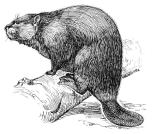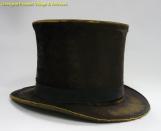1
The Hudson's Bay Company
A Brief History of the Hudson's Bay Company
2
At its height, the Hudson's Bay Company controlled close to three million square miles of land: one-twelfth of the earth's surface. It helped to define Canada as a physical entity and as a nation.Initially, the interest in North America was due to the success of fishing off the coast of Newfoundland. However, furs soon became more valuable in Europe than fish, and North America provided an abundant supply of pelts. Beaver fur was considered the most valuable, as beaver-felt hats were in vogue in Europe.
3
Beaver fur was highly prized in Europe, and was a major export of the Hudson's Bay Company Credits:
Credits:http://upload.wikimedia.org/wikipedia/commons/2/29/Beaver_(PSF).jpg
4
Until 1663, the French held a monopoly on the fur trade, with the Company of One Hundred Associates, in New France. The Huron acted as intermediaries between the French and the other First Nations groups. However, warring between the Iroquois and Huron nations meant that they could no longer hold this position, and they were replaced by men called Coureurs de Bois. By 1678, there were 600 Coureurs de Bois. The government and Church decided that hunting permits were needed. Only a limited number were issued, and those who received permits came to be known as the Voyageurs.The Dutch to the south, in present-day New York, and the British to the west, also wished to capitalize on the bourgeoning fur trade.
5
Coureurs de Bois acted as intermediaries between the French and First Nations groupsCirca 1670
 Credits:
Credits:Glenbow Museum, Calgary, Alberta
http://www.tfo.org/television/emissions/rendezvousvoyageur/fr/univers/viepersonelle/origines.html
6
On 2 May 1670, King Charles II of England granted a monopoly on fur trading in Rupert's Land and James Bay to the Company of Adventurers of England (the Hudson's Bay Company). He required that if the monarch ever visited, two black beaver skins and two black elk would be given in tribute.7
In 1670, King Charles II of England granted a fur trading monopoly in Rupert's Land to the HBCCirca 1660
 Credits:
Credits:artist: John Michael Wright
The Royal Collection, England
http://www.gwleibniz.com/britannica_pages/charles_ii/images/charles_ii.jpg
8
Prince Rupert, the favourite cousin of King Charles II, was given a land grant of all the lands and bodies of water in the Hudson Bay drainage basin, which consisted of forty percent of present-day Canada, as well as the American states of Minnesota and North Dakota. There was a provision that the land grant could be expanded to include all territory west of Hudson Bay, so that, should the Northwest Passage to Asia be discovered, the Company could control all the trade routes along the way.9
Prince Rupert of the Rhine (1619-1682), favourite cousin of King Charles II of England1640
 Credits:
Credits:The George & Dragon, Lichfield, Staffordshire, England
http://www.george-dragon.co.uk/prince rupert.jpg
10
Rupert's Land consisted of all the land in the Hudson Bay drainage basin1670
 Credits:
Credits:Created in Photoshop using
http://www.world-atlas.us/north-america-map.gif
http://images.google.ca/imgres?imgurl=http://upload.wikimedia.org/wikipedia/commons/4/49/Wpdms_ruperts_land.jpg&imgrefurl=http://en.wikipedia.org/wiki/Hudson's_Bay_Company&usg=__2tDw9v5jobV8ZXDHLjgqyO-y00c=&h=239&w=300&sz=24&hl=en&start=3
11
It was not the discovery of the Northwest Passage, but the nature of the beaver, that determined the extent of the land controlled by the Hudson's Bay Company. The beaver is a non-migratory animal that requires extensive territory, and once all the beavers had been trapped in an area, hunters had to move farther west, away from Hudson Bay. The territory occupied by the Company helped to define the boundaries of Canada. Without the Hudson's Bay Company, the occupation of western Canada would have been much weaker. The Company's workers in the west kept American colonies from expanding northward into what is now Canada.At forts and posts, Hudson's Bay Company workers and First Nations individuals would trade fur pelts for goods. The Chipewyan and Cree were important trading partners for the Hudson's Bay Company.
The beaver pelt became the standard unit of trade, and other goods were measured in relation to it.
The most valuable beaver pelts were actually those that had been worn for a time by First Nations people; this allowed the long, coarse outer fur to fall out, and the soft underfur to become matted. These were called "castor gras," and could be used immediately for felt hats, whereas unworn pelts, known as "castor sec," had to be specially prepared, by scraping off the underfur, which had to be wet, crushed, and matted into felt before it could be made into hats.
12
Beaver felt hat19th Century
Georgina Pioneer Village & Archives
 Credits:
Credits:Georgina Pioneer Village & Archives
13
At first, the Hudson's Bay Company resisted moving farther west, and relied on First Nations middlemen to trade with other First Nation peoples, and to bring the furs to posts around Hudson Bay. The HBC's biggest competition, the North West Company (NWC), operated out of Montreal, and their business was conducted mainly by Voyageurs, who paddled and portaged through the west, carrying goods directly to First Nation peoples to trade for furs. Beginning in the 19th century, the Hudson's Bay Company realised it had to change the way it operated, or lose territory to the North West Company. The HBC adapted to techniques used by the Voyageurs, and built new posts, setting rates so low that the NWC could no longer compete; however, neither company could gain a clear advantage. Pressure from the British government led to an amalgamation of the two companies into the Hudson's Bay Company. An act of Parliament passed on 2 July 1821 granted the Hudson's Bay Company control over all of British North America except the colonies of Upper and Lower Canada.14
Trappers who received permits from the French government were known as voyageurs1869
 Credits:
Credits:"Voyageurs" by Frances Anne Hopkins
National Archives of Canada
http://www.canoemuseum.net/heritage/images/heritage3_lg.jpg